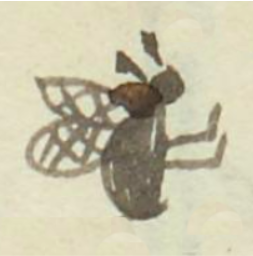Zayol (MH641v)
This black and white painting of the simplex glyph for the personal name Zayol (from zayolin, referring to a "Fly") is attested here as a man's name. The fly is shown in profile, facing toward the viewer’s right, but it is not flying horizontally. Its head is upward, and its legs and feet are stretched out in front of the bee. Its wings are therefore on the left. They have a hatched or mesh pattern that could suggest transparency.
Stephanie Wood
The gloss for this name is difficult to transcribe. It seems that the scribe began to write a name beginning with a Y. Then perhaps he changed it to a “t.” If Tzaol was meant, that would still need to be changed to Zayol, which is the current interpretation, based on the image of the insect. It is noteworthy how some glyphs provide great detail when representing insects and bugs. See some other examples below. The term for a honey bee, necuzaolin, has parts that are like nectar-fly. One wonders whether it should be written necuzayolin.
Stephanie Wood
juā tzaol (?)
Juan Zayol
Stephanie Wood
1560
Jeff Haskett-Wood
abejas, insectos, animales, nombres de hombres, Zaol

zayol(in), fly, https://nahuatl.wired-humanities.org/content/zayolin
necuzaol(in), honey bee, https://nahuatl.wired-humanities.org/content/necuzaolin
Abeja
Stephanie Wood
Matrícula de Huexotzinco, folio 641v, World Digital Library, https://www.loc.gov/resource/gdcwdl.wdl_15282/?sp=365&st=image&r=-0.792,...
This manuscript is hosted by the Library of Congress and the World Digital Library; used here with the Creative Commons, “Attribution-NonCommercial-ShareAlike 3.0 License” (CC-BY-NC-SAq 3.0).







